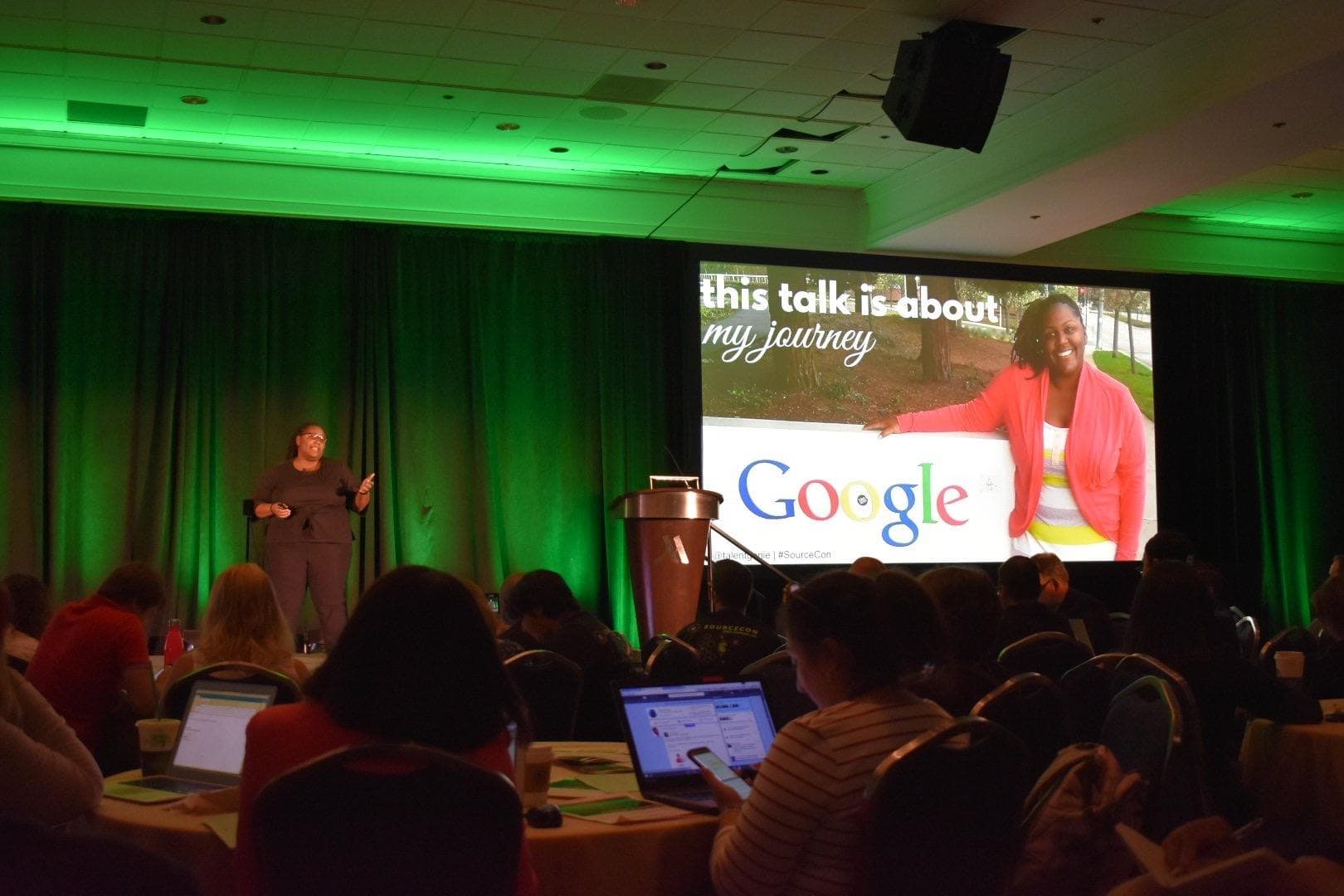There’s a rush of excitement when you watch a special person perform for the first time; it might have been the first time you saw your now favorite athlete as a rising superstar or read your first Charles Bukowski story or it might be the first time you stepped up to the lip of the Grand Canyon. Your breath is practically taken away and a slow smile creases your lips – because you just know – and you feel lightheaded from the experience.
This is what so many felt when Maisha Cannon took the stage.
To summarize her talk at SourceCon, her overriding message was not about tools, techniques, or analytics but of being an utterly informed, compassionate and engaged sourcer; of immersing yourself into the “think and act” of communities where people live their professional lives and becoming a trusted partner in their career journeys; of becoming more of a longer term advisor to hiring managers.
For all the deserved excitement around sourcing platforms, browser add-ins, and pseudo-hacking to identify people and their contact information, the first indication that she embraced recruiting as a contact sport was her story about #mallwalking and retail recruiting: Literally walking into target retail stores, playing the role of customer, then asking to speak to the manager whom she promptly hooked into her recruiting web. It’s this sourcing brashness that defined the remainder of her presentation.
Maisha’s career travel stops have included the specialty retail boutique Torrid (where she perfected the art of “secret shopping sourcing”); USC (where she fell in love with Internet research)’; Sodexo (where she learned the art of social recruiting using Twitter); and Google (where she literally vied with hundreds of other internal recruiters for the same people). You can read more about this talent genie here.
In line with her core message of being a more human Sourcer, she pointed out one of the classic problems of search – misspelled words – offering examples (Engineeer, Acccountant, Recruter) of the number of LinkedIn profiles where simply using the correct spellings to search for people severely limits the number of returned hits (incidentally, here’s a fine Social Talent post on the topic from last year, and one this year from SourceCon). Maisha further distinguished three sourcing strategies that will likely help to bear fruit in your orchards.
Move from sourcing keywords to “extracting the essence.” Since sourcing solely for keywords limits you to the scope and depth of the job description, she prefers to employ a fuzzy logic approach instead that focuses on comprehension over keywords. The fuzzy logic comes from the initial strategy session and its on-going updates and enables identification and extraction of critical phrases needed to identify the people to engage. The fuzzy logic approach also includes misspellings, phrase differentiation, and abbreviations. In one example, a pure keyword approach yielded nine results in LinkedIn whereas an essence approach produced 965 hits.
Move from a single session intake meeting to an on-going, multi-session strategy session. Maisha uses her experience as a teacher to gain the trust of hiring managers – think of it as using word play to convince an elementary school student that both milk and studying are good for them. Rather than holding an intake meeting, Cannon holds what she calls a strategy session where topics far deeper than the words on the job description are discussed and agreed upon. These strategy sessions go far beyond the job description and extend even to the members of the team where the role will reside.
Her claim that we need to “elevate the intake” into an on-going process that is collaborative, data-driven, structured and fun helps to reset managers’ expectations of what will happen during the hiring process. The key question that Maisha asks, “how much time can you invest in the process every week?” sets her up as a top advisor rather than someone who takes orders and delivers food to the table, and indirectly helps train hiring managers to become talent scouts. As further evidence that this strategy session is important, Maisha suggests that participants include the sourcer, recruiter, talent coordinator and hiring manager.
Move beyond the standard outreach templates. Maisha told the story of Pete London, a fictitious LinkedIn profile still receives InMails, years after articles were written about the engineer who created it. Of the 500+ messages received by the profile, only five were deemed personal and interesting enough to warrant a response. Time and again, the people we target give us the same feedback – if it’s personalized, we’ll respond. There are many in our industry including Maisha who believe that the metric heavy, high-pressure hiring environments actually promotes recruiter spam and make it more difficult for those who do customize to see responses.
Her model for not being a sourcing spammer?
By ADD-ing value in your initial and follow-up outreach to people: Be Authentic, Different, Delightful. Using research and whatever outreach platform resonates most with the people you’re seeking, Maisha urges us to be so custom and unique in our communication with people that they are effusive in their praise of our work. While ADD-ing takes time (e.g., finding the information to serve as the critical icebreaker – the subject line) and can limit the volume of your outreach, the quality of personalization that drives increased response rates is worth the effort.
In closing, Maisha urged the community to be present when sourcing, to not overly multitask (something Sourcers are prone to doing) – to concentrate on singular tasks at hand. Her personal model for this is an ideal reminder for the sourcing community: Be Mindful, Adaptable, Gutsy, Industrious, Consistent. Identify any part of the process that can be improved to be more helpful to the people whom we might want to join our companies.
Maisha preached that there aren’t any tricks to being a great Sourcer…just magic.
